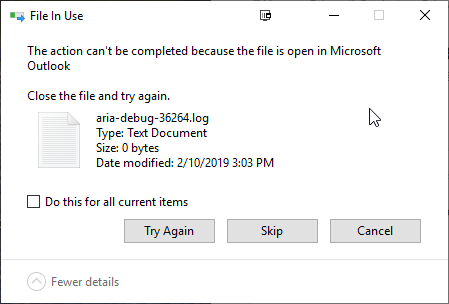-
Posts
3,790 -
Joined
-
Last visited
-
Days Won
17
Everything posted by TheSteven
-
You're probably saturated with reports & reviews of the 2019 Winter NAMM but here's a nice overview from KVR that's not mono-focused on just guitars or synths or something else. https://www.kvraudio.com/focus/winter-namm-2019-show-report-44260
-
Per iZotope - today is last day of sale (Tues, Feb 12th)
-
I just noticed that I received an email this morning time stamped 8:29 AM PST from Time+Space... Maybe because I bought TH3 from them. The discount plus the loyalty points from buying TH3 should add up to a nice sale price.
-
I received an email from Plugin Alliance this morning regarding the bug report I submitted on the VST3 issue:
-
From what I recall with this version no registration/serial#/etc. is required.
-
Just received the following email. Riffstation is a great program and is currently free. It'll be interesting to see what they replace it with. +++++++++++++++++++++ Goodbye, Riffstation Pro We are sad to announce that Riffstation Pro (Mac/PC) will no longer be available for download. We are immensely proud of the success Riffstation has experienced and of the legion of dedicated guitar players it has seen develop along the way. We'd like to thank you for your support over the years. We will be coming out with an exciting new product soon. In the meantime, if you are using an older version of Riffstation Pro, we strongly recommend that you update to the latest version now to future-proof your app. It's free to download until March 15, 2019. Download Please note that you will need Mac OS X v10.10/Windows 7 or higher to run the latest version of the application. See you soon, The Riffstation team
-
RayBlaster 2.5 currently on sale 50% off https://www.tone2.com/rayblaster2.html Nemesis 1.6 currently on sale 50% off https://www.tone2.com/nemesis.html Both of these were recently updated and the update is free. Edit: The only 3rd party reseller that I see matching these prices is https://www.bestservice.com/rayblaster_2.html
-
- tone2
- rayblaster
-
(and 1 more)
Tagged with:
-

Midi automation on instrument channel ?
TheSteven replied to lychee's topic in Instruments & Effects
Thanks! -

Midi automation on instrument channel ?
TheSteven replied to lychee's topic in Instruments & Effects
For some reason the help links you post show up in French and it looks like the English option is missing among the languages options. Any way to reset this one my end? -
I didn't know that CPM could handle the details of implementing JBridge, thanks for the info!
-
Yes EveryPlug, http://everyplugin.com, usually has the best Waves and EastWest prices. EastWest software (except for Play6) are current marked down by EW 50% . Here's a separate thread going on about the current EastWest sale...
-
Aye Fleer, nothin' but the best of cheese for this group!?
- 2 replies
-
- 1
-

-
- cheese machine
- big tick
-
(and 1 more)
Tagged with:
-
Big Tick's old classic has resurfaced. Through a special arrangement with Big Tick Audio, 2getheraudio is offering a newly remastered and updated version of Cheeze Machine - and it is free. Mac & Windows version available. https://www.2getheraudio.com/instruments/cheeze-machine-2/ Back by popular demand comes a remastered version of the extremely popular Cheeze Machine virtual instrument byBig Tick Audio. An extra cheesy, extra saucy string box in the style of the original vintage string machines. Cheeze Machine 2 includes an expanded oscillator section, convolution reverb, a vintage ensemble chorus, and 64 bit compatibility for VST, AU, AAX and Standalone applications. Also included, bonus preview presets for Cheeze Machine Pro, an upcoming release with additional filters, pitch envelopes and performance controls. Cheeze Machine 2 Specifications Vintage String Box virtual instrument plugin Two virtual analog oscillators plus a sub oscillator for super thick sounds Vintage Ensemble, Phaser and Modulation Effects Over 60 strings, brass, bass, pads and keyboard sounds Super simple interface for quick intuitive editing Ultra CPU and memory efficient!
- 2 replies
-
- cheese machine
- big tick
-
(and 1 more)
Tagged with:
-
It's preorder - $9. If you like their other stuff or are impressed by the demo video maybe it's worth a $9 gamble to commit to the preorder. I don't own any of their stuff so I can't say comment on their other efforts...
-
Also here's a KVR thread on how to use Melda's MGranualMB (not free) to create that effect. Creating risers using MGranularMB
-
You want to create a 'riser'. There are number of plugins that specifically do that - for example AIR has a plugin called 'the Riser' Most of these plugins use their own sounds & effects. Waves has a plugin, SoundShifter, that uses your audio to create that effect. I've linked a video below. It will probably eventually be on sale again at Waves for $29 but if you want it now it's currently on sale for $43.73 at http://everyplugin.com/soundshifter.html
-
JRR Shop - All EastWest 50% off Use discount code: GROUP for deeper discount in cart. https://www.jrrshop.com/computer-software?dir=asc&limit=all&manufacturer=129&order=name&sale=1&type=2 Spaces II MSRP $399 in cart with discount code: GROUP $167.58 https://www.jrrshop.com/eastwest-spaces-license
-

Update Issue - Can't get past "EXTRACTING "
TheSteven replied to stringrazor's topic in Cakewalk by BandLab
You might want to try cleaning out Windows temp files. Too many temp files or corrupted files left in the temp folder can cause issues like the one you describe. How to: First close all open programs and files. You don't need to shut down apps that run in the background. In practice I've never had an issue doing this procedure even with lots of stuff open but you'll get a better cleaning if you close the extra stuff. In Windows File Explorer open %temp% and it will take you to a folder similar to: C:\Users\<username>\AppData\Local\Temp Select all files in that folder, for example by hitting Ctrl-A, and click on Delete. When you see something similar to the screen below check the box "Do this for all current items" and click Skip. You can Google deleting Windows temp files if you need more info or just want a confirmation. If all this is new to you maybe have an experienced friend watch or help. -
@msmcleod has created a sampled piano instrument - 88 note's sampled at 7 velocity levels. Use the link below to access his original thread and the downloads. https://discuss.cakewalk.com/index.php?/topic/1477-free-piano-sound/ Please - leave all comments, thanks, etc. on his thread.
-
Per @msmcleod You need the full version of Kontakt
-
I've been waiting for a killer sale on this particular plugin for ages, possibly years. But since I've been waiting I've picked up FabFilter Pro-Q 3, so... do I have a valid justification for buying it? Arguing with my GAS over this... Have you totally mastered Pro-Q 3? um, no Are there EQ plugins in your collection that have yet to be explored? ...maybe Is this bright & shiny? YES! If finances were different I'd jump on this anyway. But then if wishes were fishes I'd be having Sushi for dinner tonight... BTW you can stack coupons and use the discount code in the email for Brainworx bx_digital V3 and if you have one, your February discount code for an even cheaper price.
- 1 reply
-
- 1
-

-
I have no problem with your opinion, I even respect it, but feel that your language is an issue. Calling people 'whores' for not seeing things the way you do doesn't endear you or make your point(s) more palatable. There are more effective ways to convey your message. Peace Out ...Steven
-
Excuse me Sir/Madam but I am a plugin slut, not a plugin whore. Minor distinction but one none the less. I respect your moral stand but disagree with your premise. Thorn is a fine synth but like many on this particular forum I already have a glut of soft synths. No disrespect to Dmitry or Thorn but the only way I'll purchase a synth at this time is if it's priced in the truly no-brainer region. So in this case PA/Dmitry have collected $19 from me that they would never have otherwise received. I have no idea why this 'situation' occurred - be it intentional, as KK suggested it might, or otherwise. But as it appears from comments posted on this thread it was not universally offered/distributed to Dmitry's user base. If nothing else it has generated attention to the PA/Dmitry relationship. One point that you don't take indignation over - - making people who've already purchased Thorn pay $19 just to obtain the rebranded PA version and perhaps be able to get future updates (assuming those don't require a fee). The amount is IMHO a bit steep, I'd not be thrilled if I fell in that camp.




